Can someone please help me with the following questions so I
Can someone please help me with the following questions so I can double check my work? No explanation needed just the answer is fine.
8. U.S. GAAP and IFRS require firms to account for minority, active investments, generally those where the investor owns between _____ using the equity method. Under the equity method, the investor recognizes as revenue (expense) each period its share of the net income (loss) of the investee. The investor recognizes dividends received from the investee as a return (reduction) of investment, not as income.
a.
10% and 50%
b.
20% and 50%
c.
30% and 50%
d.
40% and 60%
e.
50% and 60%
25. Purchaser Corporation acquires 30% of the outstanding voting common shares of the Investee Corporation for $600,000. Purchaser Corporation acquires the investment in Investee Corporation by buying previously issued shares of Investee Corporation from other investors. When Purchaser Corporation acquired 30% of Investee Corporation’s common shares for $600,000, Investee Corporation’s total shareholders’ equity was $1.5 million. Purchaser Corporation’s cost exceeds the carrying value of the net assets acquired by $150,000 [ $600,000 - (0.30 x $1,500,000)].
Purchaser Corporation attributes the $150,000 excess purchase price as follows: $100,000 to remeasure buildings and equipment to fair value and $50,000 to goodwill. Which of the following is/are true?
a.
Purchaser Corporation does not reclassify this excess out of its Investment in Stock of Investee Corporation account to Buildings and Equipment and to Goodwill.
b.
Purchaser Corporation must amortize (or depreciate) any amount attributed to assets with limited lives.
c.
Purchaser Corporation must depreciate the $100,000 attributed to buildings and equipment over their remaining useful lives.
d.
U.S. GAAP and IFRS do not permit the investor to amortize the excess purchase price attributed to goodwill and other assets with indefinite lives. Instead, the investor must test the investment account annually for possible impairment.
e.
all of the above
32. Pareto Corporation owns 40% of Spring Corporation. During Year 3, Spring has net income of $60,000. What entry should Pareto record related to its investment in Spring during Year 3?
a.
Investment in Spring Corp. 24,000
Equity in Earnings of Affiliate 24,000
b.
Dividend Receivable 24,000
Dividend Income 24,000
c.
Investment Receivable 24,000
Investment Income 24,000
d.
Investment in Spring Corp. 24,000
Investment Income 24,000
e.
Investment in Spring Corp. 24,000
Cash 24,000
35. Pense Co. purchased 40% of the stock of Stretch Co. in Year 1 for $100,000. Stretch had net income in Year 1 of $50,000 and net income in Year 2 of $30,000. Stretch also paid total dividends of $20,000 in Year 2. On January 1, Year 3, Pense Co. sold its investment in Stretch Co. to GE Capital Corporation (GE) for $130,000. What entry would Pense Co. make to record the sale of Stretch Co.?
a.
Cash 130,000
Gain on Sale 6,000
Investment in Stretch 124,000
b.
Cash 130,000
Loss on Sale 2,000
Investment in Stretch 132,000
c.
Cash 130,000
Loss on Sale 10,000
Investment in Stretch 140,000
d.
Cash 130,000
Loss on Sale 30,000
Investment in Stretch 160,000
e.
Cash 130,000
Loss on Sale 20,000
Investment in Stretch 150,000
55. Intercompany sales
a.
do not need to be eliminated as long as the sales have been completed to an outside party.
b.
must be eliminated from both the sales and cost of goods sold accounts.
c.
do not need to be eliminated if made at arm\'s length values.
d.
must be eliminated only if not in the ordinary course of trade or business.
e.
do not need to be eliminated.
54. To avoid double counting P\'s investment in S, P must eliminate
a.
the investment in S and S\'s separate company shareholders\' equity.
b.
all debt on S\'s separate company financial statements.
c.
any dividends paid against the cash account.
d.
all intercompany transactions.
e.
all of the above.
58. U.S. GAAP view investments of over 50 percent of the voting stock of another company (for the purpose of controlling the other company at the broad policy-making level and at the day-to-day operational level) as
a.
minority, passive investments.
b.
minority, active investments.
c.
majority, passive investments.
d.
majority, active investments.
e.
marketable securities.
33. If Wabasso Company pays $55,000 in dividends to its corporate investor Lament Corporation (Lament owns 35% of The Wabasso Company), what entry should Lament Corporation record when it receives the dividends?
a.
Cash 55,000
Dividend Income 55,000
b.
Cash 55,000
Investment Income 55,000
c.
Cash 55,000
Investment in Wabasso Company 55,000
d.
Cash 55,000
Additional Paid-in Capital 55,000
e.
Cash 55,000
Common Stock- Wabasso Company 55,000
25. Purchaser Corporation acquires 30% of the outstanding voting common shares of the Investee Corporation for $600,000. Purchaser Corporation acquires the investment in Investee Corporation by buying previously issued shares of Investee Corporation from other investors. When Purchaser Corporation acquired 30% of Investee Corporation’s common shares for $600,000, Investee Corporation’s total shareholders’ equity was $1.5 million. Purchaser Corporation’s cost exceeds the carrying value of the net assets acquired by $150,000 [ $600,000 - (0.30 x $1,500,000)].
Purchaser Corporation attributes the $150,000 excess purchase price as follows: $100,000 to remeasure buildings and equipment to fair value and $50,000 to goodwill. Which of the following is/are true?
a.
Purchaser Corporation does not reclassify this excess out of its Investment in Stock of Investee Corporation account to Buildings and Equipment and to Goodwill.
b.
Purchaser Corporation must amortize (or depreciate) any amount attributed to assets with limited lives.
c.
Purchaser Corporation must depreciate the $100,000 attributed to buildings and equipment over their remaining useful lives.
d.
U.S. GAAP and IFRS do not permit the investor to amortize the excess purchase price attributed to goodwill and other assets with indefinite lives. Instead, the investor must test the investment account annually for possible impairment.
e.
all of the above
20. Pagoli Corporation acquires 30% of the outstanding voting common shares of the Inform Corporation for $600,000. Pagoli Corporation acquires the investment in Inform Corporation by buying previously issued shares of Inform Corporation from other investors.
Between the time of the acquisition and the end of Pagoli Corporation’s next accounting period, Inform Corporation reports earnings of $80,000; and pays a dividend of $30,000 to holders of its common stock.
Inform Corporation reports earnings of $100,000 and pays dividends of $40,000 during the subsequent accounting period.
Pagoli Corporation’s Investment in Stock of Inform Corporation account now has a balance of:
a.
$609,000
b.
$621,000
c.
$633,000
d.
$642,000
e.
$657,000
| a. | 10% and 50% |
| b. | 20% and 50% |
| c. | 30% and 50% |
| d. | 40% and 60% |
| e. | 50% and 60% |
Solution
8. Option B
26. Option D, U.S. GAAP and IFRS do not permit the investor to amortize the excess purchase price attributed to goodwill and other assets with indefinite lives. Instead, the investor must test the investment account annually for possible impairment.
If FV goes below the purchasing price/historic price then company should give effect to this impairment
32. Option A
Investment in Spring Corp. 24,000
Equity in Earnings of Affiliate 24,000
35 Option A
Cash 130,000
Gain on Sale 6,000
Investment in Stretch 124,000
55. Option B must be eliminated from both the sales and cost of goods sold accounts because company cannot record sales to itself
33. Option C
Cash 55,000
Investment in Wabasso Company 55,000
Dear student, an expert is allowed to answer initial 4 sub parts in a question. However I have done more than that correctly. Please give it a like if its helpful. Thanks
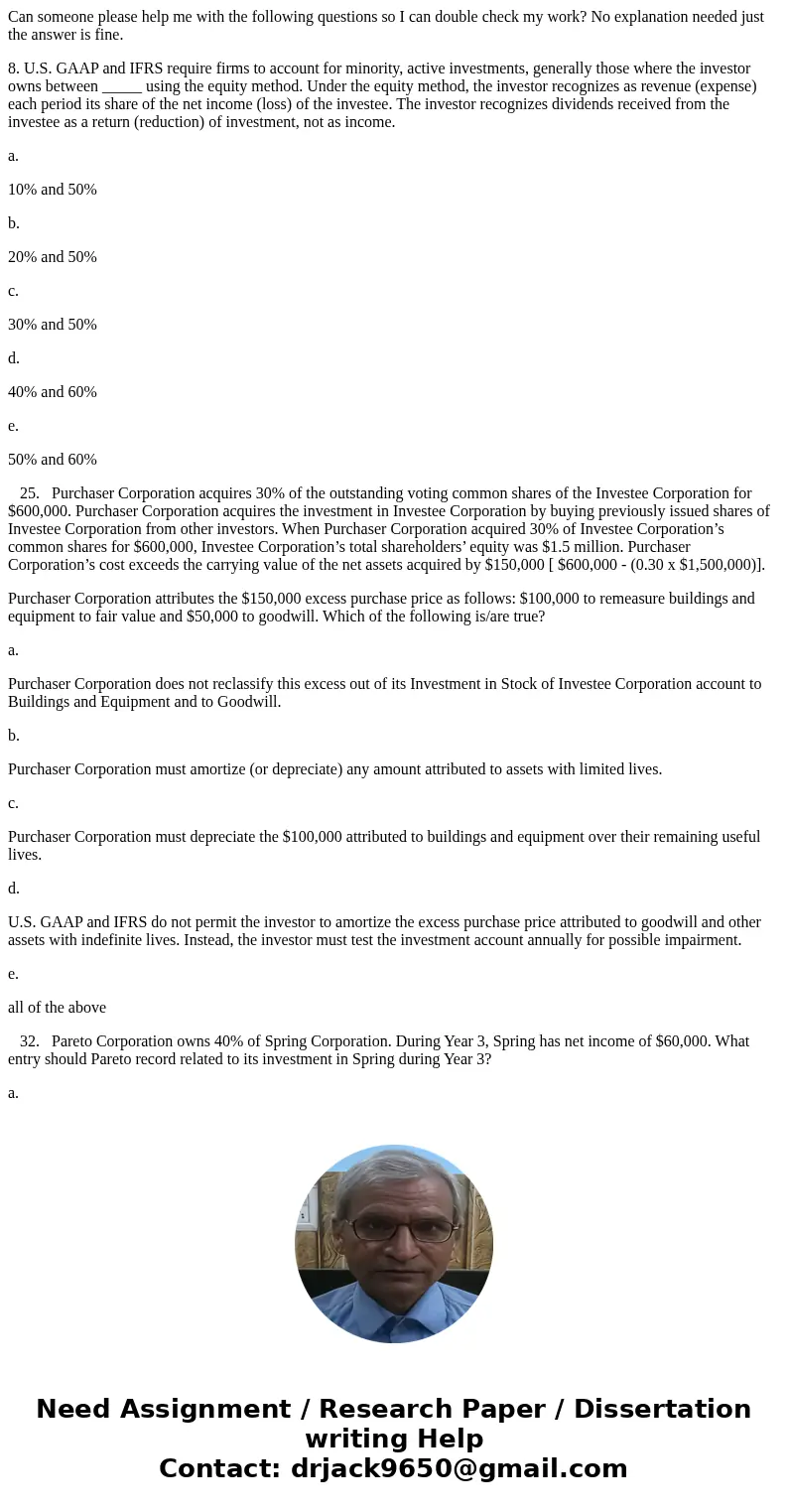
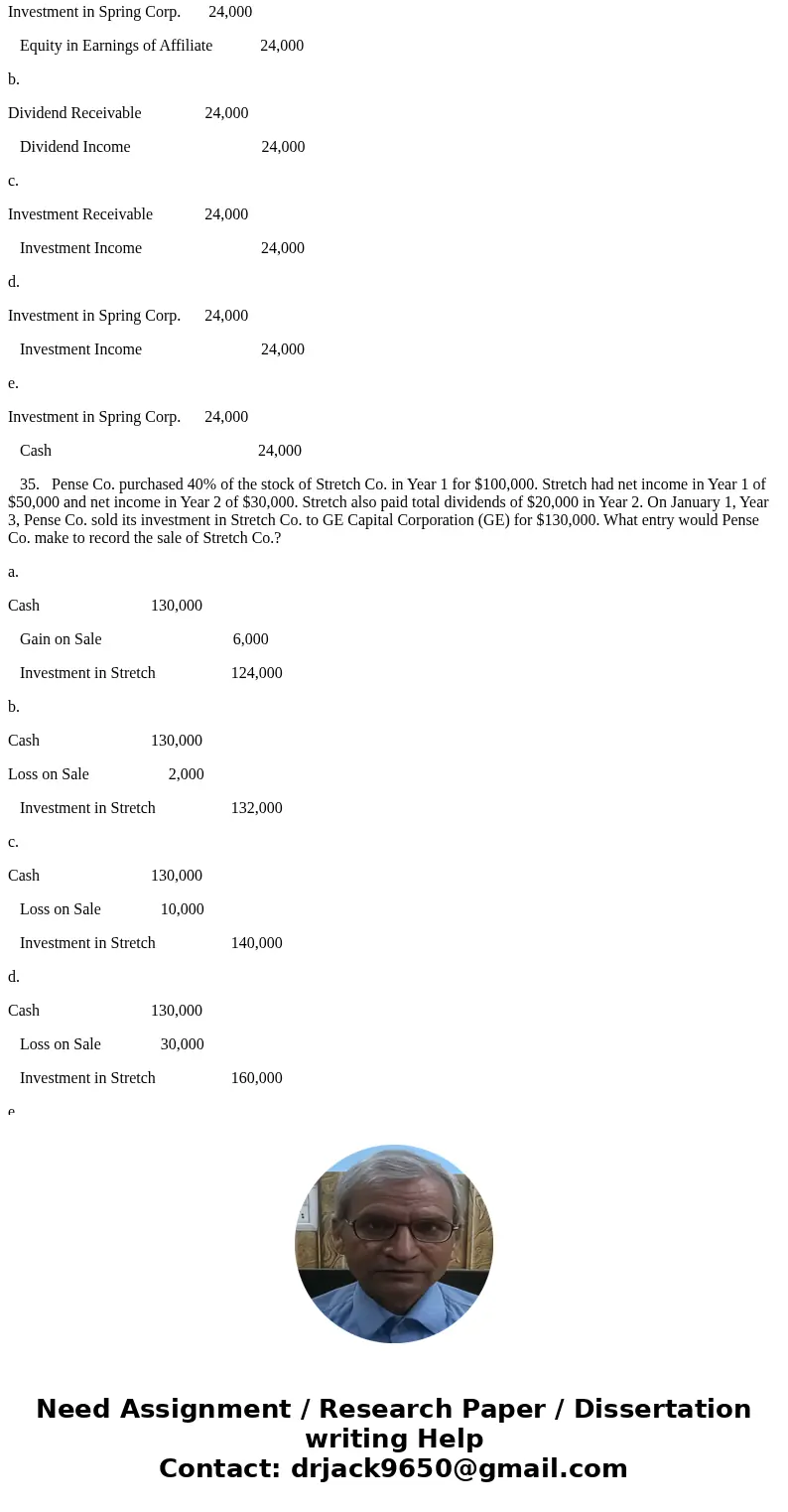
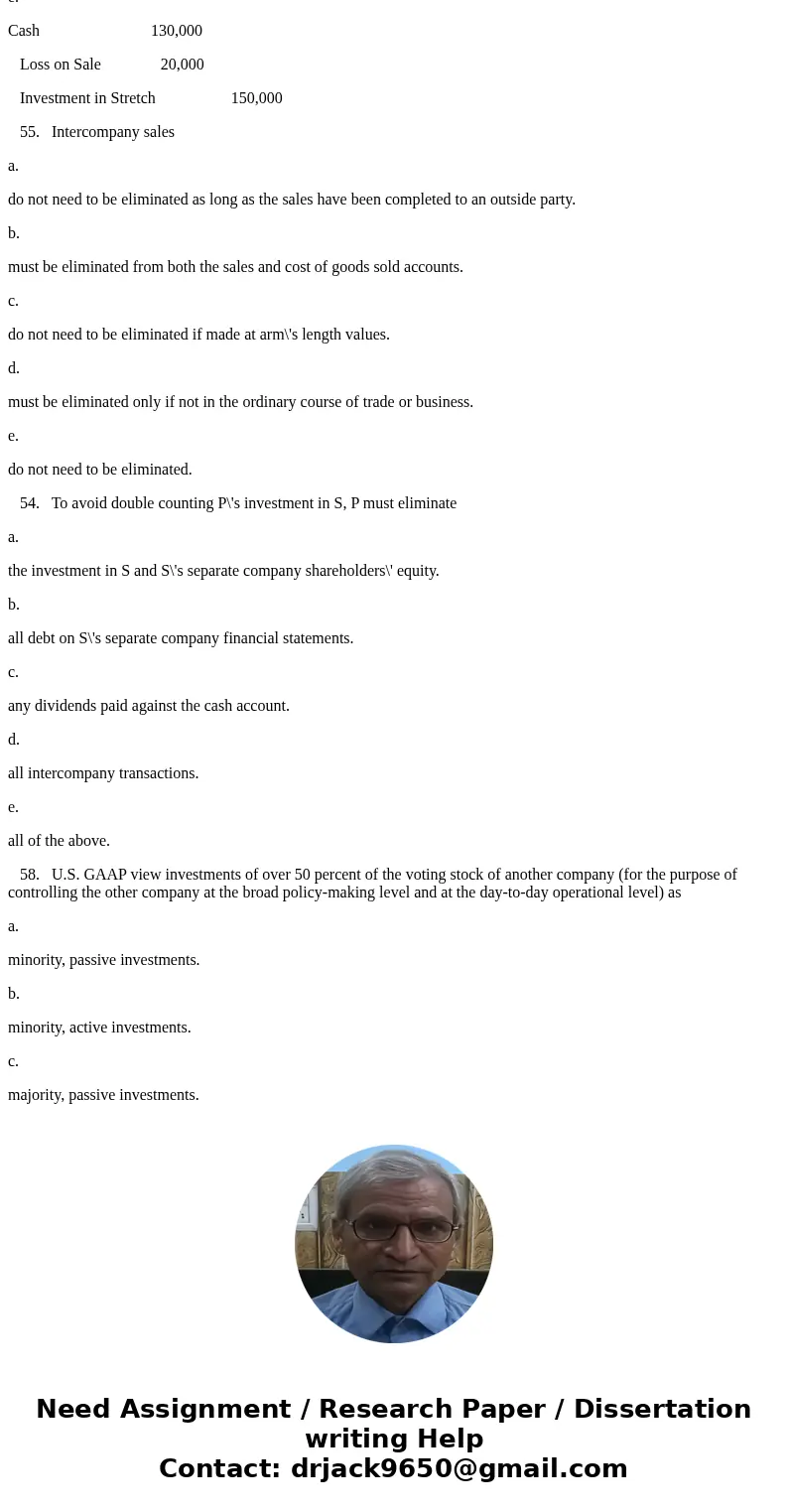
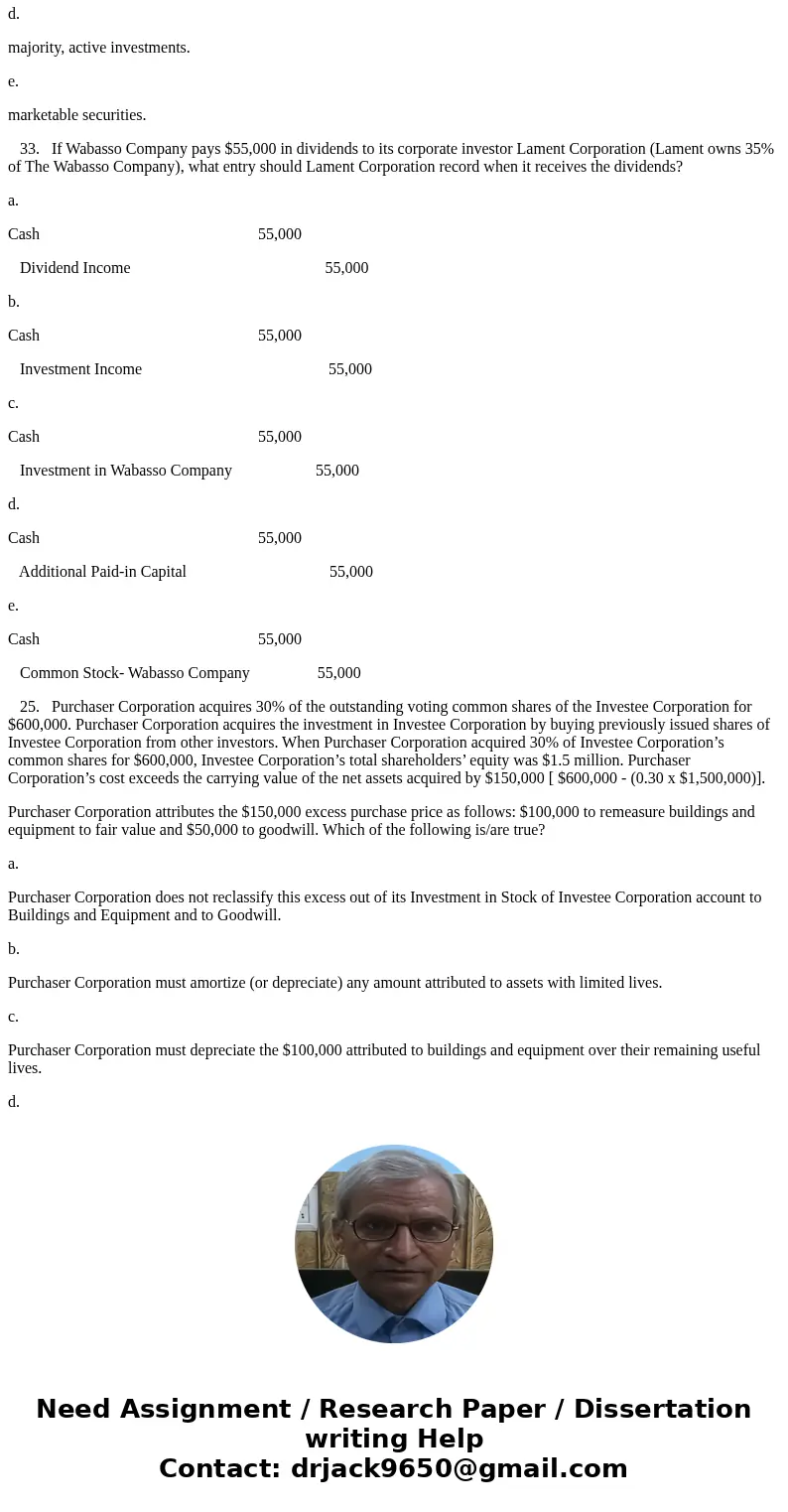
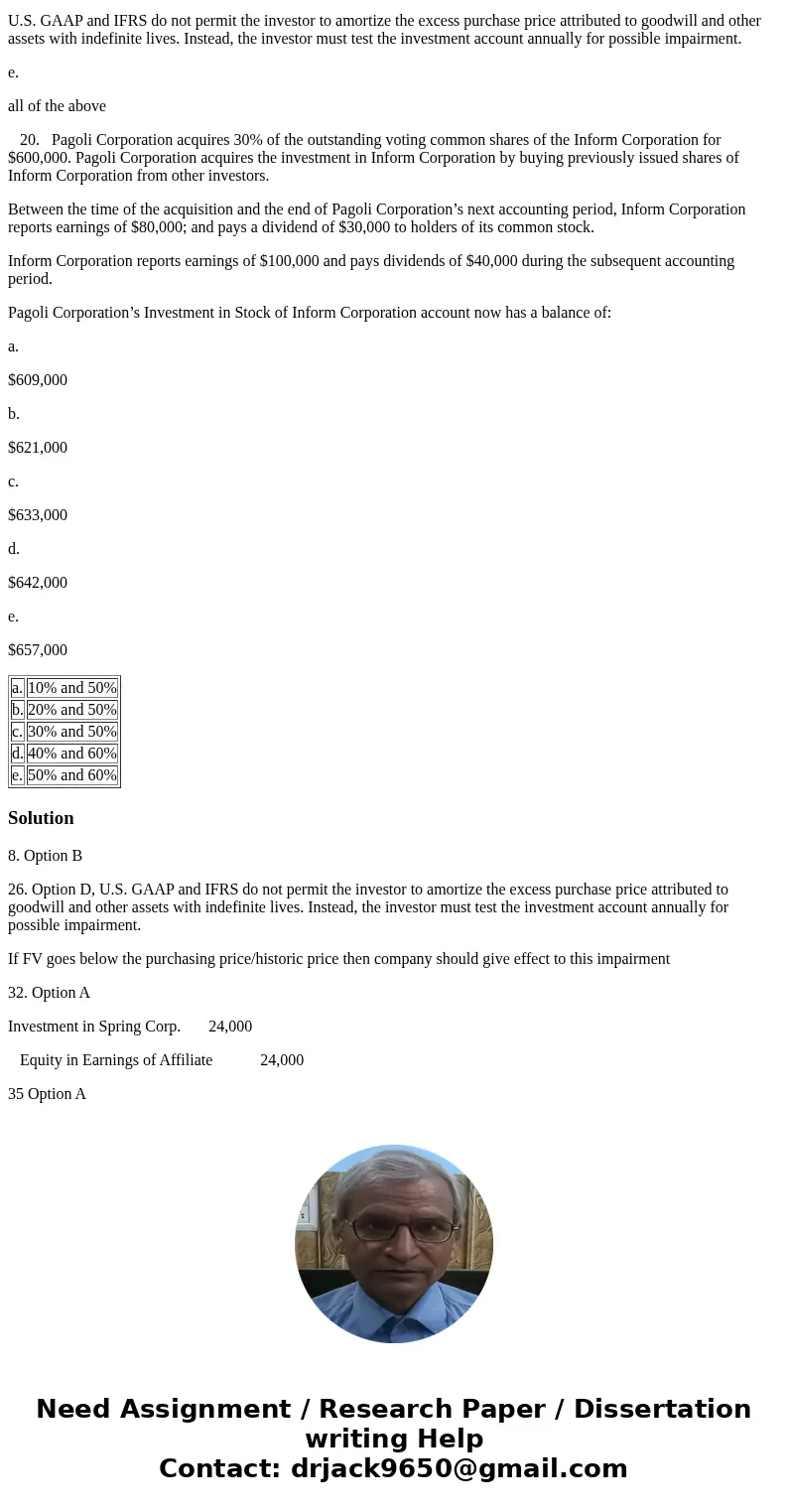
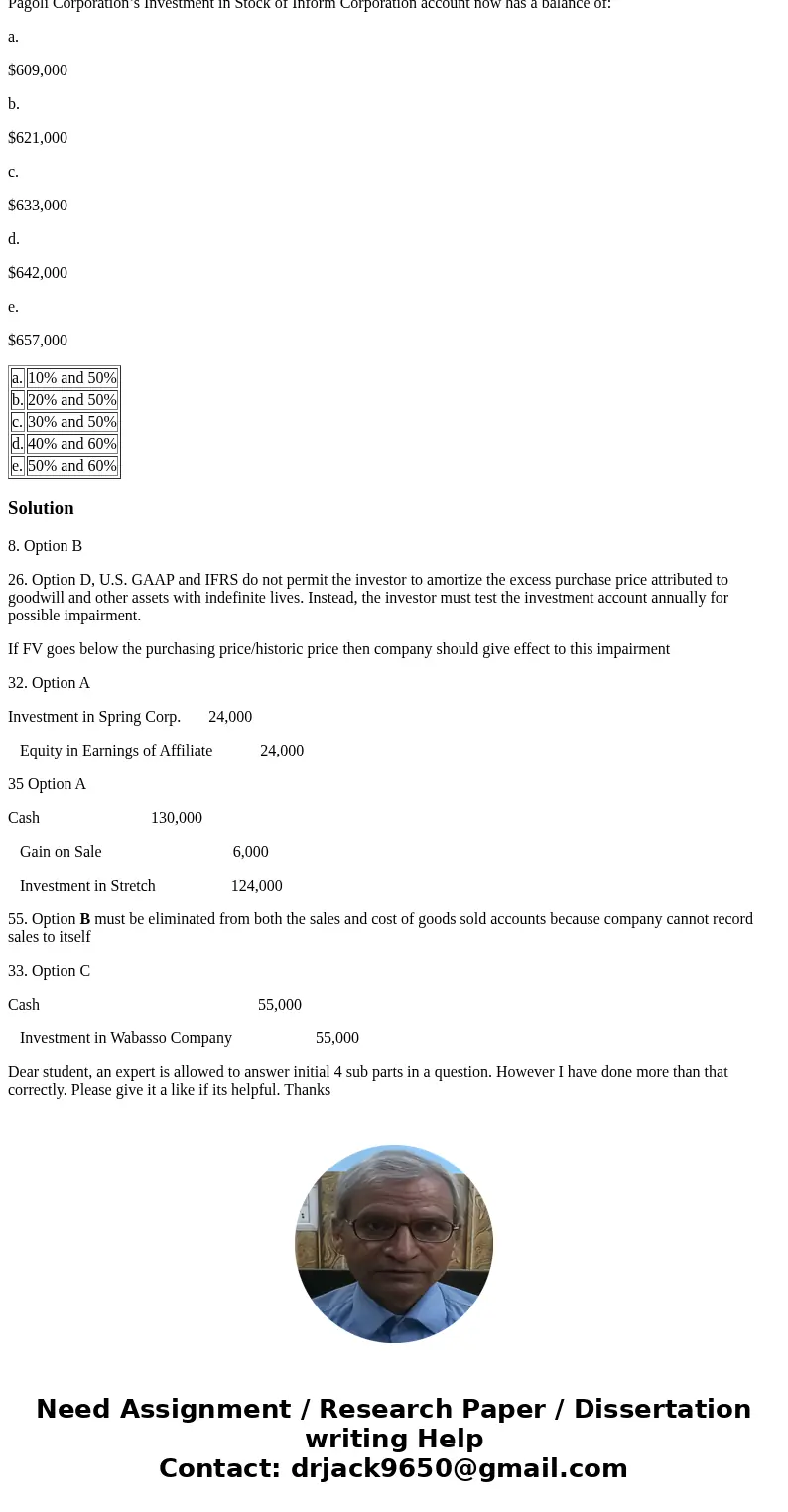
 Homework Sourse
Homework Sourse